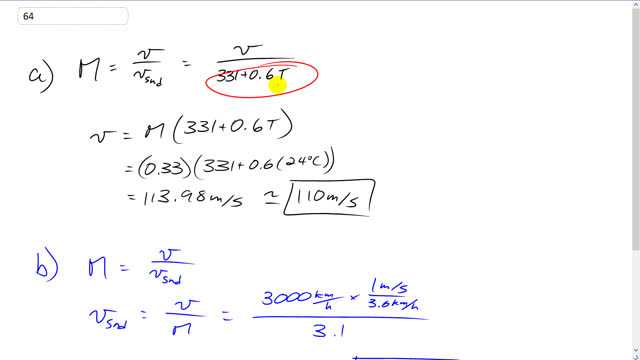
- How fast is an object moving on land if its speed at is Mach 0.33?
- A high-flying jet cruising at 3000 km/h displays a Mach number of 3.1 on a screen. What is the speed of sound at that altitude?

In order to watch this solution you need to have a subscription.
This is Giancoli Answers with Mr. Dychko. The Mach number is calculated by taking the speed of the object divided by speed of sound. So, that's the speed divided by 331 plus 0.6 times the temperature in Celsius for a speed of sound. And we can solve for v by multiplying both sides by this denominator, 31 plus 0.6 t. Multiply that by it and multiply M by that as well. And so we have M times 331 plus 0.6 t, that's 0.33 times 331 plus 0.6 times 24 degrees Celsius and that gives about 110 meters per second with a Mach speed of 0.33. And then part b is, what's the speed of sound at altitude of whatever this high flying jet is cruising at. And we can solve this for v sound by multiplying both sides by v sound over M. And so on the left side the M’s cancel, leaving us with v sound. And on the right side we have the speed of the plane divided by M. The speed of the plane is 3,000 kilometers per hour which we converted into meters per second by multiplying by 1 meter per second for every 3.6 kilometers per hour. And then we divide that by 3.1 the Mach number. Then we add about 270 meters per second must be the speed of sound at this high altitude. And we expected this speed of sound to be lower at high altitude than it is near the ground because the air is less dense at high altitude.